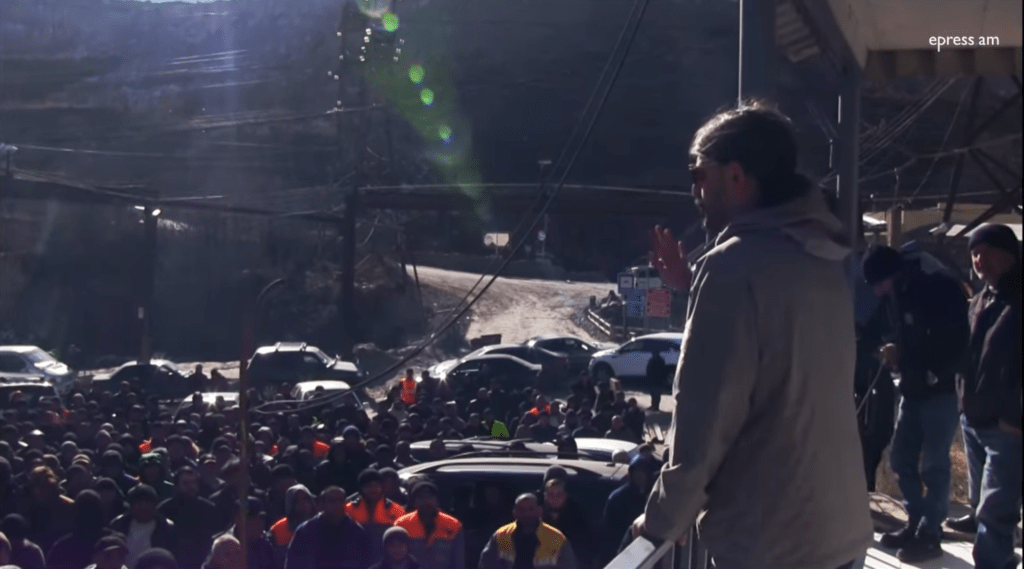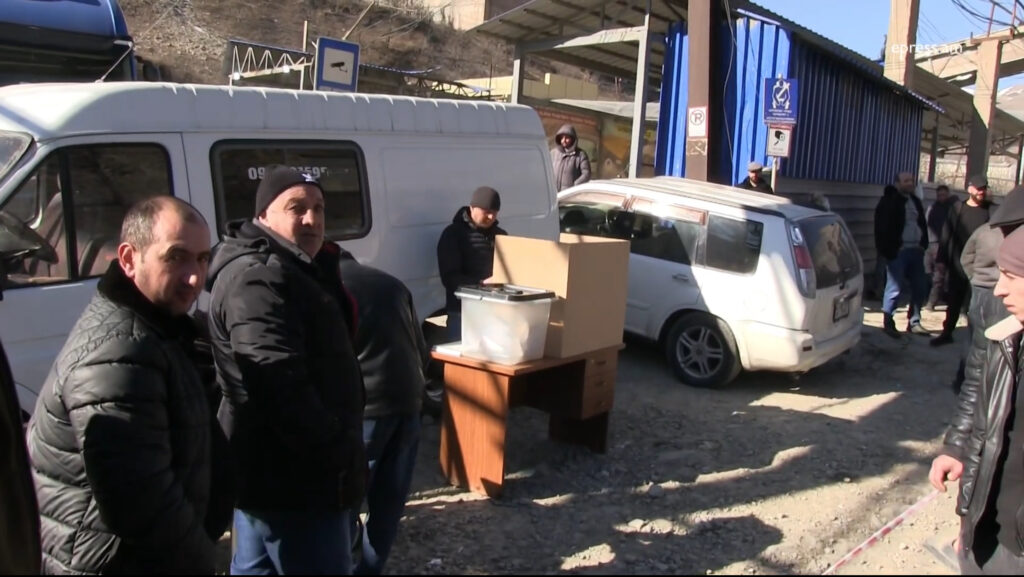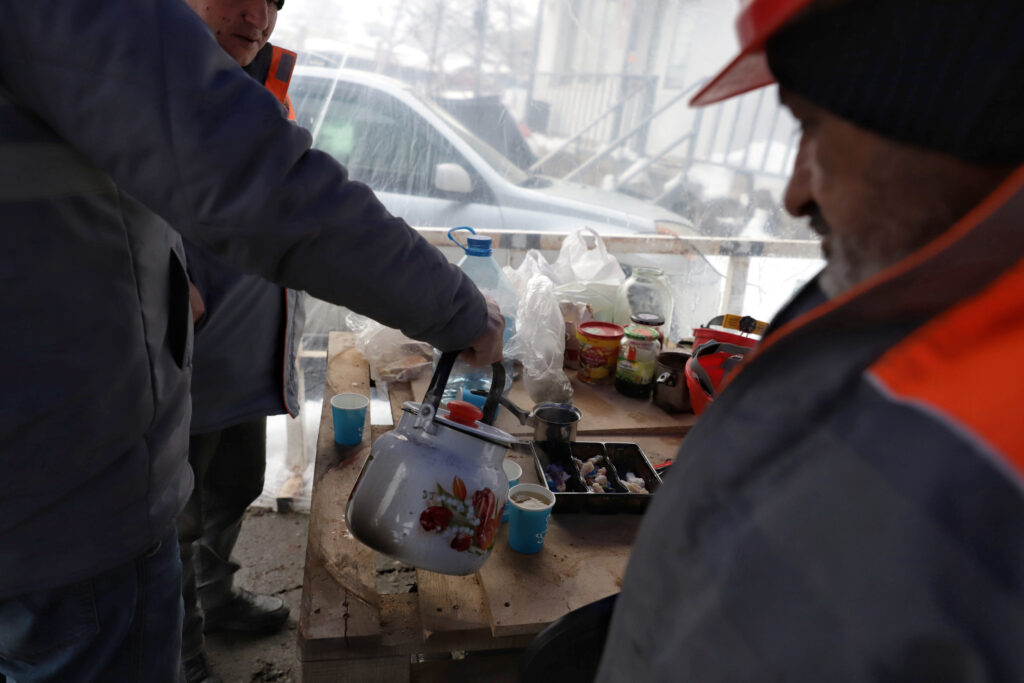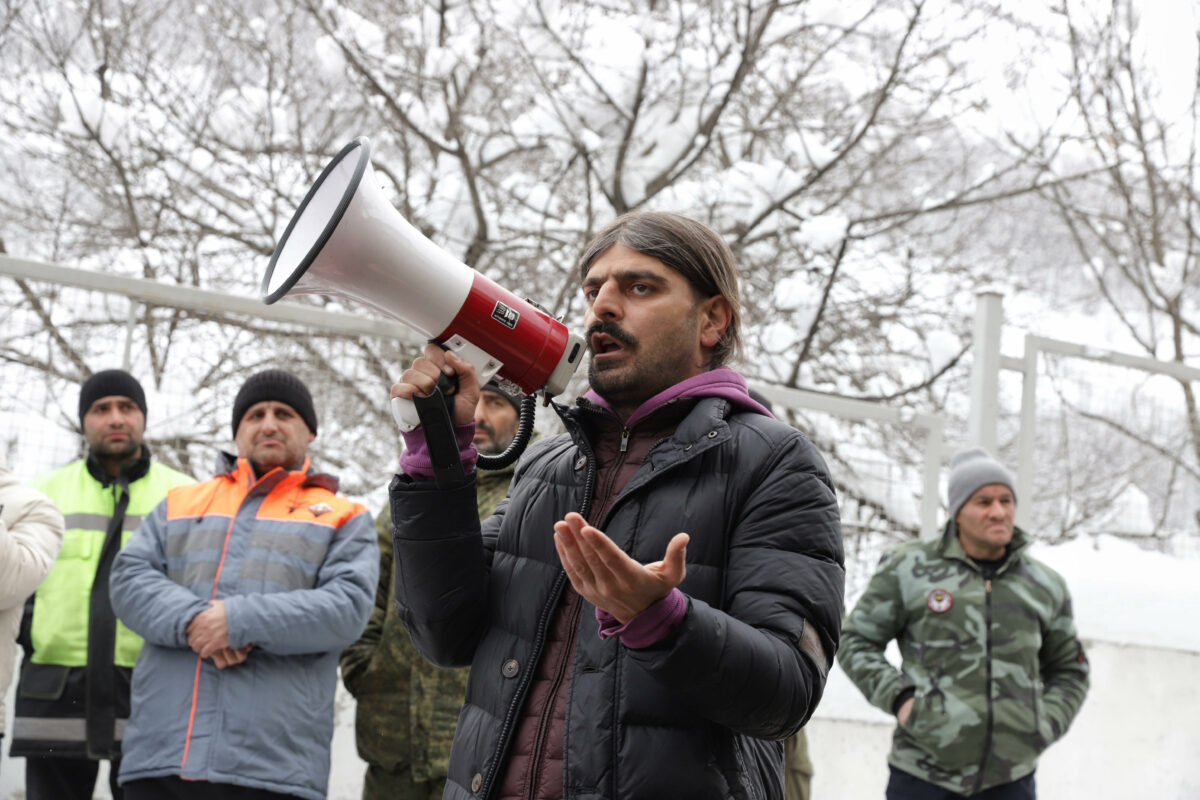
LeftEast has kept the author of this article anonymous to protect them.
From January 31st to February 10th, workers at the Zangezur Copper-Molybdenum Combine (ZCMC) in southern Armenia, the country’s largest mining company and its biggest taxpayer, went on a wildcat strike to protest what they described as inhumane and unsafe working conditions and unfairly low wages. Pointing to the inadequate compensation for their work, they demanded a 50% wage raise as well as vast improvements to their working conditions. More than 2000 workers participated in the strike, while both the management and the Yerevan-based President of the Confederation of Trade Unions of Armenia dismissed the legality of the strike.
The ongoing struggle of the workers against their management and the state reveals the state of labor movements and class politics in Armenia, with workers demonstrating innovative organizing methods and engaging in a fascinating bottom-up collective action endeavor. These miners in a rural town in southern Armenia are up against corporate greed, the government’s self-interest, and geopolitical power structures looking to crush their spirits and restore the exploitative working conditions with threats of legal action. With the strike still recent and the potential for renewed organizing, it is worth examining the conditions that led to it and the reactions various stakeholders have shown over these past days.
Industrial Ruination: A post-Soviet story
A class struggle in any post-Soviet country can almost always be traced to the collapse of the Soviet Union, the demise of the welfare state, and the rampant privatization of Soviet industrial infrastructure. In the 1990s, Armenia experienced the collapse of the Soviet supply chains and an energy crisis prompted by its war with neighboring Azerbaijan over the Nagorno Karabakh Autonomous Oblast. Deindustrialization in Armenia began much earlier, triggered by the Spitak Earthquake in 1988, which destroyed factories in the northern regions of the country. The process of deindustrialization persisted, with the remaining industrial production focusing primarily on extractive industries and the export of raw materials. In the early days of the post-Soviet period, Armenia’s emerging elites showcased a ferocious appetite for its industrial infrastructure, as it began to be privatized in the most disorganized and war profiteering manner possible, making the former nomenklatura the winners of the race to transfer ownership of state-owned enterprises to themselves.
ZCMC is Armenia’s largest mining company and a top 10 molybdenum company worldwide. According to its website, in 2023, it had a 3.8% market share in the global molybdenum market. It is the leading taxpayer in Armenia, with taxes exceeding $250 million in 2024. In 2020, it was Armenia’s fourth-largest employer. Like most industrial companies in Armenia, it is a Soviet remnant with over 70 years of history. According to Azatutyun, in 2004, it was privatized for $40 million, with 60% of its shares sold to a German company called Cronimet. The rest of its shares had always, in one way or another, been owned by Armenian political capitalists such as the third president, Serzh Sargsyan, and people connected to him.
It is important to note that in recent years, the Armenian government came to own nearly 22% of the company. Back in 2021, Prime Minister Nikol Pashinyan declared the company’s shares had been owned by Armenian oligarchs: ‘’Enough is enough that ZCMC’s shareholders are a bunch of marauders.’’ According to Azatutyun, since 2021, the majority of the plant shares were purchased from Cronimet by companies associated with Russian billionaire Roman Trotsenko. Following the purchase of the shares, Trotsenko donated a total of 21.8% of the company’s shares to the Armenian government. As a result, the government is currently entangled in court battles over the legality of Trotsenko’s buyout, facing a $1.2 billion lawsuit, the biggest in Armenia’s history, in the World Bank’s International Centre for Settlement of Investment Disputes. The lawsuits are filed by a minority shareholder company associated with Armenian and Russian oligarchs, claiming that before selling its shares to Trotsenko, Cronimet had a legal obligation to prioritize, as per the ZCMC charter, fellow shareholders as potential buyers.
In 2021, Pashinyan met with Trotsenko officially, and the two announced plans for further cooperation and investment in Armenia, including the construction of a new copper smelting plant. It appears that the Armenian government has provided Trotsenko with legal cover to monopolize the country’s mining sector. In return, with Trotsenko’s financial support, the government was able to reduce the stakes held by shareholders linked to Robert Kocharyan and Serzh Sargsyan, securing control over 22% of ZCMC, with additional investment commitments.
‘’Let the laborer live like a human’’
Resources for legal proceedings play a crucial role in this story. The striking workers claimed that, without the trade union advocating for their rights, they had little knowledge of the legal procedures required by the Labor Code to initiate a lawful strike. With no alternative venues to voice their concerns, they felt they had no choice but to proceed with a wildcat strike. Two hundred workers of ZCMC went on a strike on January 31st, spending the night on factory premises. They demanded a 50% increase in wages and improvements to their working conditions. In media interviews, the workers continuously demanded that the management release their average salaries and compare it to the average salary of the workers of ZCMC, ‘’Let’s take a look at the tenfold difference in earnings between the working class and the management.’’ (source epress.am).
The workers’ media interviews revealed profound and unsettling feelings of injustice across various company departments and ranks. One issue that was consistently raised was the luxurious cars driven by the company’s management while the workers struggled to make ends meet and must take out loans to keep their households afloat. The workers emphasized that the strike was spontaneous, with no political machinations behind it, likely out of a fear that the government would label them as counter-revolutionary, as it has done with any protest movement in Armenia over the past seven years.
The workers were also vocal about the unsafe working conditions they endure without proper health insurance, with many highlighting that they had to cover industrial injury costs through personal loans. Syunik province, where the company is located, has historically been a mining hub, leaving a devastating impact on both the environment and the local population. In media interviews, striking workers frequently raised concerns about the high cancer rates among them. They also pointed to the inadequate healthcare infrastructure in their town, which often forced them to travel all the way to Yerevan for medical treatment.
Below are some of the testimonies provided by the workers to Armenian media outlets:
‘’The roads the laborers have to walk on are like this [points to the rough roads], but they [the management] only walk on paved roads, and they get them cleaned so they don’t have to breathe in the dusty air. […] They have brought five Russians [referring to the company management] and they administer these 5000 workers however they like.’’ (source epress.am)
‘’The laborer only asks for one thing: let us live, we are human too.’’ (source epress.am)
‘’If they threaten us with dismissal and so on, we women will stand by our men—we will block the road, we will continue our demands.’’ (source Azatutyun)
‘’If there is a war, they [the management] will be the first ones out of here, these laborers will be the ones called to the frontlines.’’ (source epress.am)
After the strike began, the company management and the President of the Confederation of Trade Unions of Armenia denounced the workers and issued statements saying the strike was unauthorized and not in line with the Labor Code. The company management has gone so far as to accuse the striking workers of being driven by political interests. They claimed that the workers’ salaries are higher compared to other industries in Armenia and insisted that only a small group was involved in the strike. Moreover, they released the gross salaries of some of the workers, presenting them as net salaries, which sparked outrage among the strikers.
In a fascinating development, on February 2nd, the workers organized a public vote to decide if they had a majority to continue the strike, with participation visible to all, but the votes themselves were kept private. According to Azatutyun, the ballot read, ‘’Do you support the strike organized with the demand for higher wages and improved working conditions?’’ Two thousand four hundred forty-eight out of the company’s more than four thousand workers voted in favor of continuing the strike.

The management skipped negotiations on February 4th, telling the workers it would only negotiate with them after they resumed operations. One of the strike organizers addressed the workers after the negotiations fell through: ‘’The government has an obligation to come down here and solve this issue. We are not asking them; we are demanding. It has to look after us; we are being harassed here. […] We live in a democracy; let us see if this is a real democracy or not. This is not just an issue concerning workers, this concerns the whole community surrounding it [ZCMC]’’ (source epress.am).

On February 7th, ZCMC fired eight workers who were active in the strike organizing, which prompted the President of the Confederation of Trade Unions of Armenia to finally take a stand against the company’s methods. She stated that workers had a right to fight for better working conditions and that firing them was an unnecessary escalation. Workers believed this retaliation was done to scare them into returning to work. Reminder: This is a small town in southern Armenia. Mass layoffs will ultimately cost the company more, as hiring new employees will take time, and quickly training them to cut production costs will be even more challenging. Many of the workers are long-time employees with deep knowledge of the company’s history and institutional memory; a workforce purge would be costly.
However, this consideration did not stop ZCMC from threatening to replace the striking workers, according to a striker’s interview published by epress.am: “They’ve told us, ‘If you don’t want to work, don’t. We’ll bring in other laborers—Indians and Tajiks.’’ However, the workers did not think this threat could materialize, as one told epress.am, ‘’We are not slaves in our own city.’’ With their colleagues fired, the workers proceeded to demand their reinstatement and written guarantees from management that if they resumed work, there would not be retaliatory layoffs.
Neoliberal elites and the fallout from a deficient revolution
Armenia’s political elites, be it the ruling party or its oligarch-funded opposition in the parliament, have already taken a side. Not surprisingly, both the neoliberal corporatists (the government) and the political capitalists (the oligarchs) agree on the issue of cost reduction via labor exploitation and unsafe working environments, maximizing shareholder value, which in this case is them. ‘’We’ve been here for three days, and there’s nothing from the government’s side—no one is reaching out,’’ told a worker to epress.am. on the third day of the strike.
On February 5th, the Minister of Economy said, ‘’The best situation for the Ministry of Economy is for the mine to operate, because Armenia’s interest stems from this, as operating the mine means job creation, economic growth, continued export growth, tax payments, and so on. […] The Ministry of Economy should hope that the negotiations between the union workers and the management of the organization will eventually result in the mine operating as soon as possible.’’ The government’s silence, public neutrality, and emphasis on the tax losses Armenia was accruing during the strike was telling since, in the past, it had rarely shied away from reaching out and co-opting popular social movements driven by populist working-class demands.
During the 11 days the strike lasted, the Armenian government failed to even acknowledge the concerns of the workers, putting economic benefit before the people who brought it to power. These workers are to whom the 2018 revolution belongs, not the neoliberal ruling elites who have spent the past years chastising the working class of Armenia as provincial simpletons telling them their material reality is a result of their own shortcomings: lack of education, employability, and positive outlook on life.
Nikol Pashinyan and his Western-educated cabal will do well to remember they came to power through a protest movement against Armenia’s oligarchical class, which was dispossessing and exploiting the Armenian working class for decades. His attempt to build civic nationalism around the 2018 regime change will fail because he was never its symbol. Its symbol has always been the everyday working person, and as one striking ZCMC worker has told Azaturtyun, ‘’You can’t defeat us. Yes, you tried, you pressured us a bit, but you know what? The people here will not break. No, people will stay until the end.’’
On Monday, the strikers reached an understanding with ZCMC to resume work after the company announced a 20% wage increase, the selection of a new health insurance provider offering better packages, and the installation of modern air conditioning systems by the end of 2025. Whether the conditions of the agreement will be held remains to be seen, as the fired eight workers promised to take the matters to court if they are not reinstated.

